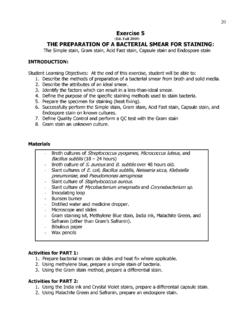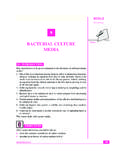Transcription of Exercise 12 Biochemical Characteristics - bulletworm.com
1 61. Exercise 12. Selected Biochemical Reactions Used to Identify the Physiological Characteristics of Bacteria (with special reference to Gram Negative Enteric Rods). INTRODUCTION: Student Learning Objectives: After completing this Exercise students will: a. Demonstrate the ability to recognize physiological differences between different bacterial species. b. Describe and define the principles of the Biochemical tests used to identify bacteria based on their enzymatic properties and their byproducts. c. Set up a battery of tests to identify specific Gram Negative Enteric Rods. Activities: - Perform the Oxidase test. - Inoculation of carbohydrate fermentation tubes (Glucose, Lactose, sucrose ). - Inoculation of TSI agar.
2 - Inoculation of Urea broth . - Inoculation of Simmons citrate agar. - Inoculation of SIM agar. - Inoculation of MR-VP medium for the Methyl Red and Voges-Poskauer tests. - Inoculation of Phenylalanine Agar. - Inoculation of Moeller Lysine Decarboxylase broth . - Inoculation of MIO (Motility, Indole, Ornithine) deeps. - Inoculation of Starch agar plate. - Inoculation of DNAse agar plate. - Inoculation of Gelatin agar. 62. Materials - Work in groups of 4 per table. This is a group activity. The following agar/ broth media: Slant cultures of the following bacteria: Alcaligenes faecalis Fermentation tubes: E. coli Glucose broth w/ Durham tube Salmonella Lactose broth w/ Durham tube Proteus vulgaris sucrose broth w/ Durham tube Enterobacter cloacae TSI agar slants Pseudomonas aeruginosa Urea broth Klebsiella pnuemoniae Simmons Citrate agar slants Citrobacter freundii SIM agar tubes Serratia marcescens MR-VP broth tubes Morganella morganii PAD agar slants Bacillus subtilis.
3 Lysine Decarboxylase broth (and base) Iodine solution Optional 10% Ferric Chloride (Arginine Decarboxylase broth ) Kovac's Reagent (Ornithine Decarboxylase broth ) Barrit's reagent A and B. MIO agar tubes Sterile toothpicks Starch agar plate Inoculating loop and needle DNAse agar plate Tube rack Gelatin agar tubes Microbiology Atlas Oxidase strips Sterile mineral oil Sterile cotton swabs Introduction: Many bacterial species, unlike mammalian and plant species, can share the same morphology (rods, cocci, spirilli), so in other words can look the same under the microscope. How do you differentiate between the species, especially if they are morphologically similar? Bacteria are placed in different families based on Gram reaction, and other Biochemical reactions that they carry out utilizing specific substrates in the media they grow on.
4 Classification at the species level takes into consideration more of these Biochemical reactions, based on enzymes and byproducts of these reactions. Examples of these enzymes are urease, decarboxylase, citrase, deaminase, reductase, gelatinase, DNAse, tryptophanase, and desulfurase. Sugar fermentation into acids and alcohols are also considered among these reactions. In this Exercise , you will demonstrate a positive and a negative reaction to several Biochemical tests used in the identification of bacteria. While no single test can identify a particular species, many tests are utilized to do so. This refered to as a Test Battery, which you will use to identify your unknown bacteria in this lab. Make sure you READ and UNDERSTAND the methods of inoculation and incubation, and the principle of each test.
5 Read the material in your Atlas and look for the photos of both positive and negative reactions, and always know what the uninoculated media looks like without any growth. Use coloring pencils to draw the reaction color changes. 63. 1. Oxidase Test The purpose of this test is to determine the presence of the oxidase enzymes. This test was originally devised to identify all Neisseria species, but later came into use to separate the Pseudomonas, a Gram negative rod, from the oxidase-negative Enterobacteriaceae. The oxidase test is based on the bacterial production of an intracellular oxidase enzyme. This oxidase reaction is due to the presence of a cytochrome oxidase system, which activates the oxidation of reduced cytochrome by molecular oxygen, which in turn acts as an electron transfer system.
6 In the oxidase test, cytochrome oxidase produced by the microorganism does not directly oxidize the p-phenylenediamine reagent, but rather oxidizes cytochrome c, which in turn oxidizes the reagent to form a purple-colored compound. In essence, the oxidase test determines the presence or absence of cytochrome c. Lab Procedure: 1. You will use oxidase paper strips for this test unless indicated otherwise. 2. Using a sterile wooden tooth pick, pick a portion of the colony to be tested and rub directly onto a portion of a reaction area of the oxidase strip. Up to three tests can be accommodated. Use Pseudomonas aeruginosa and E. coli as test organisms for this Exercise . 3. You may need to add a very small drop of water if the colony is too dry.
7 4. Examine the reaction area for the appearance of a dark purple color within 20 . 30 seconds. NOTE: Color development after 30 seconds should be disregarded. 5. Record your results below. Oxidase-positive colonies => colony becomes dark purple. Oxidase-negative colonies => no color change in colonies or a light pink color imparted due to the reagent. Species Oxidase +/- Enteric or Non-enteric Pseudomonas aeruginosa E. coli Precautions The use of a platinum inoculating loop or needle or wooden toothpick to remove colonies for oxidase testing is recommended, because the presence of any trace of iron (nichrome) can catalyze the oxidation of the phenylenediamine reagent, resulting in a false positive reaction.
8 - Weak oxidase producers may appear negative within the time limits of the test. - Mucoid Pseudomonas aeruginosa may require longer than 10-20 seconds to become positive. - Oxidase reactions of gram-negative bacilli should be determined on colonies obtained from nonselective and non-differential media to ensure valid results. - Media with bile (like MacConkeys) will inhibit oxidase. Use BAP or Chocolate Agar. - Needs 24 to 48 hr. fresh oxidase enzyme. Oxidase negative will become oxidase positive with time. 64. 2. Carbohydrate fermentation tests In this Exercise , you will be using a fermentation tube test which contains a carbohydrate (Glucose, Lactose, or sucrose in this case), a phenol red broth (pH.)
9 Indicator and nutrient broth medium), and an inverted small Durham tube to collect the gas if it is produced as a result of fermentation. Lab Procedure: Label four sets of tubes (Each set has Glu, Lac, Suc) with the corresponding species and pertinent information; E. coli, P. vulgaris, E. cloacae, and P. aeruginosa. Inoculate them accordingly, and incubate 24-48 hours at 37 C. Read the results and record. Positive fermentation reaction => Yellow (acid production). Positive fermentation reaction + Gas => Yellow and bubble in Durham tube Negative reaction => Red with Growth but no change (No acid production). Purpose: Principle: Results: Conclusion: Draw your tubes below with the reactions 65. 3. Triple Sugar Iron (TSI) test In this Exercise , you will be using this medium to determine the ability of an organism to break down a specific carbohydrate (glucose, lactose, or sucrose ), with or without the production of gas, along with the determination of possible hydrogen sulfide.
10 Lab Procedure: Label 5 TSI slants with the following species: Alcaligenes faecalis, Morganella morganii, Salmonella typhimurium, E. coli, and Citrobacter freundii. Inoculate this slant agar medium with the inoculating needle; aseptically, pick up a colony with the tip of the needle and stab the medium all the way down to the bottom of the tube (butt). Then, withdraw the needle from the butt and streak the slant surface (fishtail). Incubate 24- 48 hours at 37 C. Observe for changes in color in the regions of the slant and the butt. Results are displayed as Slant/Butt, with the letter A. for acid (Yellow color), and K for alkaline. Hydrogen sulfide production is indicated by a black color in the medium, and gas production shows as cracks and bubbles in the medium.


